Aioli
Aioli is mayonnaise’s more delicious garlic-flavored cousin, and it can be spread on sandwiches, used as a dip for veggies, served as a condiment for Homemade French Fries, and so much more. It’s made from scratch with a bowl and whisk in less than 10 minutes, with only 5 ingredients.
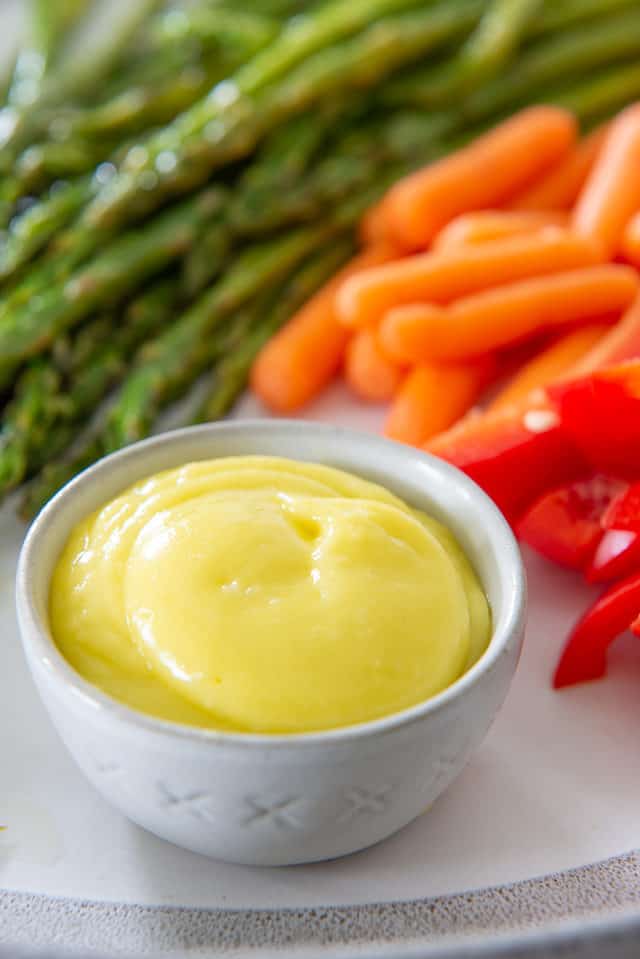
For a long time I thought of Aioli as restaurant food, meaning fancy-sounding and complicated. If only I knew earlier that it’s outrageously easy to make at home.
If you’ve ever seen my mayonnaise post, I use a food processor to make that, but for aioli I don’t think there’s a point to breaking out the machinery.
We only use the egg yolk here instead of the whole egg, and about half the oil that the mayonnaise calls for. There’s a little bit of whisking, but not an amount that will make your arm feel like it’s about to fall off. So feel free to leave the immersion blender in the cabinet.
It’s actually nice to have a bit less to work with here, as freshly made aioli will not last you more than 4-5 days. I’ll share plenty of ways to use it further down in the post, but my two favorite uses are for sandwiches and potato recipes (like Homemade French Fries…oh boy do I love fries dipped in aioli).
Tips for Best Results
Whisk the oil in slowly – This should be relatively easy to manage since you’re making the aioli by hand instead of using a machine, but whisking the oil in slowly makes for the creamiest and thickest end results. Take your time.
Buy fresh garlic in the bulb, not pre-peeled garlic – I know it’s tempting to buy those big plastic tubs of peeled garlic for convenience, and that’s totally justifiable for recipes like Chicken with Forty Cloves of Garlic where you’re using tons of garlic. But for this recipe, buy fresh garlic in the bulb and peel it fresh for the recipe.
Season well – You’ll notice that the recipe calls for salt and fresh lemon juice to balance out the flavors of the aioli. Feel free to add more salt and fresh lemon juice per your taste. The acidity of the lemon is especially important for balancing out the richness of this condiment.
Step by Step Overview:
In a large and very clean mixing bowl, combine one large egg yolk, kosher salt, lemon juice, and pressed garlic cloves.

You may also add black pepper if you wish. I leave it out for appearance.
I prefer to use an actual garlic press (affiliate) here instead of mincing the garlic finely, because it almost “juices” the garlic so that the garlic flavor distributes really well into the spread.
If you don’t have a garlic press, mince the garlic as finely as you can, then smash it with the side of your knife to turn it into more of a garlic paste.
Alternatives to raw egg yolk?
I want to comment for a moment on the egg situation. The egg in aioli is indeed raw, and personally I have been eating raw eggs in nibbles of chocolate chip cookie dough, chocolate cupcake batter, and other recipes for years without issue.
If you Google ‘how many eggs have salmonella,’ you will see articles (like this one from Slate) that discuss this risk, and it’s estimated that about 1 in 20,000 eggs has salmonella. That number is small enough that I just go ahead and eat raw eggs when the situation comes up. You are far more likely statistically to get sick from other foods that you probably don’t think about as much, like lettuce.
However, if you prefer, you can purchase pasteurized eggs to use here, or you can even pasteurize them yourself. I’ve seen lots of tutorials online for this.
Whisk the ingredients to combine:
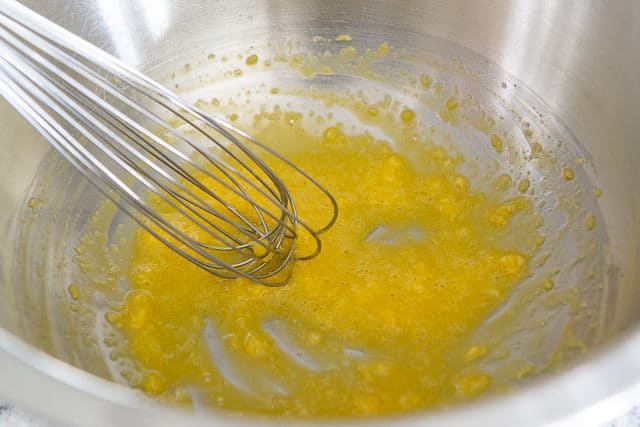
As you whisk, slowly drizzle in a little bit of your oil of choice:

I prefer to use extra-virgin olive oil or avocado oil, but really any oil will work here so long as you enjoy its flavor.
Other common choices are grapeseed oil, vegetable oil, and canola oil, but I do not cook with these oils for health reasons.
Start with just a few drops and little drizzles of oil, and whisk for about 15-20 seconds, until incorporated. You can see it starting to thicken:
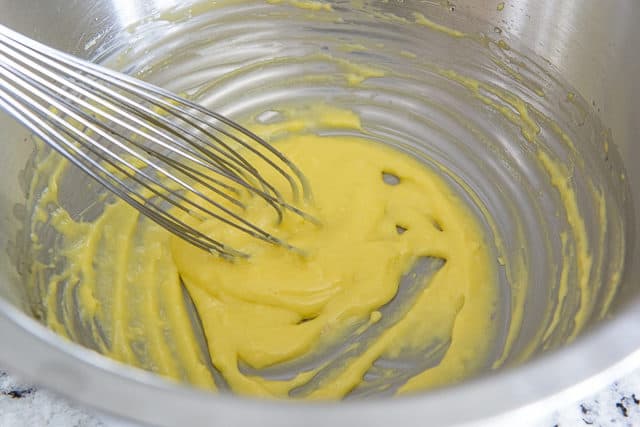
Keep drizzling in the oil slowly, until the oil is fully incorporated and you achieve a thick and creamy texture.
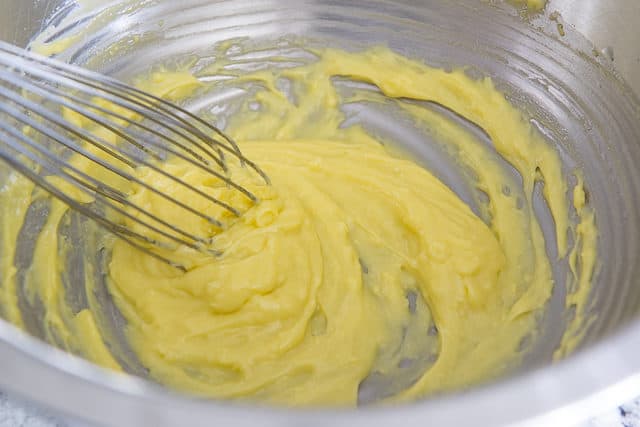
As a general rule of thumb, the longer you take to drizzle in the oil, the thicker your aioli will be. This is true of homemade mayonnaise too. I usually take about 60-90 seconds total to incorporate the oil, which ensures a properly emulsified sauce.
For a thinner aioli, whisk the oil in more quickly overall, but still start slowly at the beginning with only a few drops, and proceed with a thin stream as the egg incorporates the oil.
Flavor Ideas
A traditional aioli is very simple, as we’ve done here. But there are many different variations you can make if you’d like to add other flavors. This can really take the experience to a whole new level!
Fresh herbs – Whisk in your favorite fresh herbs at the end. I love fresh thyme, rosemary, or even fresh dill when serving this with fish entrees like Baked Salmon or Crab Cakes.
Black garlic – Whisk in black garlic paste at the end to taste, for a deeply umami flavor.
Djion mustard – Whisk in your favorite mustard at the end, either a smooth Dijon or a grainy mustard.
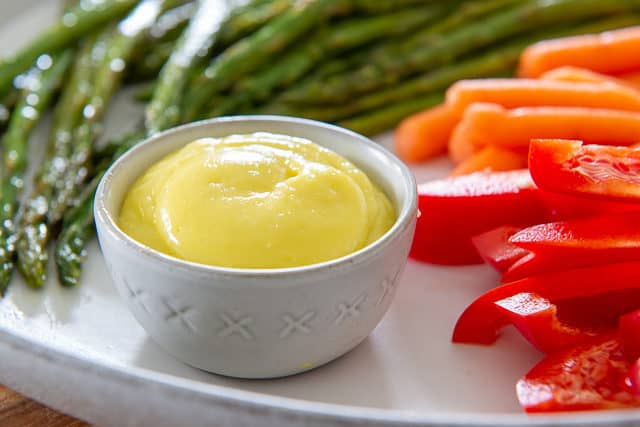
How to Serve
Serve your homemade aioli cold or at room temperature with foods like Potato Croquettes, Steak Fries, and Crispy Smashed Potatoes. Potatoes and aioli are a match made in heaven, and fries are always better with a dipping sauce!
This is also great served with Salmon Cakes, and you can mix in other sauces to make flavored aioli. For example, try stirring in some Roasted Red Pepper Sauce or Basil Pesto.
I also have this recipe for Fingerling Potatoes with Dipping Aioli that’s made a little differently, with a piece of vinegar soaked bread.
This recipe is gluten-free, dairy-free, keto friendly, paleo, and Whole30 compliant.
Recipe Tips and FAQ
Store in an airtight container in the fridge for up to 5 days.
Not recommended. The emulsion won’t survive and it will get chunky.
This is a judgment call that only you can make. As I discuss in the post, it is estimated by the CDC that 1 in 20,000 eggs have salmonella, so the odds in my opinion are very low. Statistically you are more likely to get sick from foods like lettuce. If you can find them, you can use pasteurized eggs here.
You cannot warm up aioli in the microwave or on the stove or the emulsion will break, but if you take the aioli out of the fridge 30 minutes before you want to serve it, it won’t be quite as cold.
Did you enjoy the recipe? Please leave a 5-star rating in the recipe card below and/or a review in the comments section further down the page. Or, follow me on Facebook, Instagram or Pinterest!

Aioli
Ingredients
- 1 large egg yolk*
- 1 tsp pressed garlic (3 to 4 small cloves)
- 1 tsp fresh lemon juice
- 1/2 tsp kosher salt
- 1/2 cup olive oil**
Instructions
- In a large, very clean mixing bowl, combine the egg yolk, garlic, lemon juice, and salt. Whisk for about 30 seconds by hand, until combined.
- While whisking, drizzle in a few drops of olive oil. After a few seconds of whisking, the olive oil should be incorporated, so start drizzling in a little bit more. Generally speaking, the slower you add the oil, the thicker the aioli will be. After the first few drops, I start adding the oil in a light stream. It should take about 60-90 seconds total to incorporate the olive oil.
- Once the aioli is thick and creamy, taste it and make any necessary seasoning adjustment.
- The aioli is best served within 24 hours, but is good for up to 5 days in the fridge. You can enjoy it spread on a sandwich like Chicken Cordon Bleu Panini or Croque Madame, with potato dishes like Crispy Smashed Potatoes, or with roasted vegetables like Prosciutto Wrapped Asparagus. Enjoy!
Notes
Nutrition
Nutrition is estimated using a food database and is only intended to be used as a guideline for informational purposes.

4 Comments on “Aioli”
Great basic aioli recipe, thanks! I used a microplane to grate the garlic and it all came out perfectly.
I guess there is as many ways to do an aioli as there are chefs or wannabees.
My way of doing a really chunky aioli is to soak two slices of white bread (cut off the brown sides) in some full cream milk. After soaking then squeeze out all, yes I mean all the moisture from the milk and put the remaining bread in a mortar, it is a bit chunky already by now. I find that it is important as opposed of the recipe above, to use the mortar to squeeze, bang, mash, hit, hammer… the garlic cloves together with the moistend white bread. Using a garlic press doesn’t give the same nice and smooth taste of the garlic as you get when you gently smash it in the mortar.
Once done with this most important part mentioned above you can continue with the rest as described in the recipe above.
So good! Tasted just like the aioli I get with fries at my favorite restaurant.
This is really nice Blog for me. I am your regular blog reader.
your blog is always good.
thank you for sharing this.